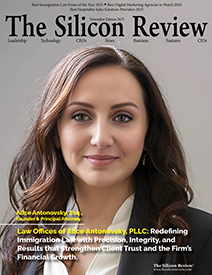50 Best Workplaces of the Year 2022
A company with the vision to enhance the professional life of people who are Deaf or hard-of-hearing: Sorenson
The Silicon Review
![]()
Because accommodations are not in place in many settings, people who are Deaf or hard-of-hearing often find it difficult to communicate effectively in workplace settings. This can result in isolation and a lack of inclusion and acceptance. In addition, when Deaf people can’t seamlessly communicate with colleagues and team members, their talents and contributions to the business can be minimized. Sign language interpreters, captioning devices, and other tools can help bridge the gap and facilitate seamless communication and participation on a level playing field.
Sorenson is a global leader in providing communications services to people who are Deaf, hard-of-hearing, diverse, and those who have unique learning styles. The company was founded in 2003 on a vision of enabling meaningful human connections between Deaf and hard-of-hearing people, as well as between the Deaf and hearing communities. Sorenson Video Relay Service® (SVRS®), the company’s first offering, leveraged video compression technology introduced by Founder James Lee Sorenson. This innovative technology revolutionized communication for Deaf people, creating new opportunities for engagement and inclusion. Since its inception, Sorenson has grown from 40 employees to 11,000 today, and is one of the largest private employers of Deaf people in America.
In conversation with Jorge Rodriguez, CEO of Sorenson Communications
Q. Can you explain about your services in brief?
Sorenson is one of the world’s leading language services providers and the world’s leading provider of accessible communication for Deaf and hard-of-hearing people. The company combines patented technology with human-centric services to connect signed and spoken languages. Sorenson Video Relay Service combines innovative products with the highest-quality, professional interpreters to enhance communication and connection. Sorenson’s CaptionCall phone captioning services connect hard-of-hearing people, who need captions to use the telephone effectively, with the people in their life at no cost. Sorenson is also the world’s leader in sign language interpretation, providing on-site, in-person interpreting, real-time event captioning, and sign language interpretation. Sorenson’s Sign Language Interactions is a leading provider of interpreting services, including 999 emergency services, for Deaf and DeafBlind people in the U.K.
Q. Growing the company based on employees’ passions must be the priority. Do you ask your employees what they are interested in doing and how they would like to see their career unfold?
We are passionate about our mission to connect people across languages, cultures, and countries – and we want employees to join us in our commitment.
Q. How has emerging technologies contributed to the success of your business?
Sorenson is leveraging cloud services to optimize its own operations, support business growth, and enhance service delivery. A new relationship with Amazon Web Services (AWS) is designed to support Sorenson’s digital transformation from on-premises data centers to virtual, automated infrastructure. Cloud-based services are supporting provision of sign language interpreting for international customers served from Canada, Puerto Rico, France, and the company’s U.K. office, as well as interpretive services provided by Sorenson for AWS events, including “re:Invent,” AWS’s flagship conference. Sorenson is also investing in artificial intelligence (AI), natural language processing, and machine learning to enhance automated speech recognition (ASR) capabilities, which are essential to expanding the availability of real-time captioning services. In addition, through a strategic partnership and investment in Canary Speech, Sorenson is exploring the use of digital biomarkers in AI-enabled speech technology, specifically to analyze vocal information and enhance diagnostics and health-related outcomes. The technology has the potential to monitor health in a non-invasive manner, and to track the presence and severity of a variety of targeted diseases, such as anxiety, depression, and cognitive decline.
Q. Do you have any new services ready to be launched?
Sorenson continually works to enhance and expand its suite of offerings. One area of focus is remote workforce collaboration tools that integrate video, voice, and captioning to enable Deaf and hard-of-hearing people to seamlessly engage with hearing colleagues in work environments by asking questions and providing feedback. Recent announcements include an expansion of on-demand captioning, including communication access real time translation (CART) and transcription services, in higher education. This initiative will provide critical information to students, faculty, and staff with unique visual and linguistic learning styles, with services designed to accommodate different approaches to learning and support an inclusive learning environment. Demand for these services is increasing among colleges and universities looking to drive recruitment, enrollment, engagement, and graduation rates.
Meet the Leader behind the success of Sorenson Communications
After joining Sorenson as CEO in January of 2022, Jorge Rodriguez executed a vision to build diversity and inclusion within the organization. At the time of his appointment, there was one person of color on the board. Today, seven of nine board members are people of color. Women and people of color now comprise almost 60 percent of Sorenson’s C-Suite, compared to no people of color and only one female executive at the end of last year. Across the entire leadership team, up through and including VP levels, 50 percent of the Sorenson team is now people of color, compared to three percent last year. In addition, Rodriguez appointed the first Deaf C-level executive. Most of these changes were implemented in the space of four to five months.
Rodriguez is also committed to enhancing and expanding the scope of Sorenson’s capabilities and services, specifically to enable inclusion and the broad acceptance of Deaf and hard-of-hearing people, as well as those with unique learning styles. By leveraging his extensive experience in telecom and technology services, Rodriguez is looking to apply innovative tools and 21st-century platforms to allow Deaf, hard-of-hearing, and diverse people to communicate on an equal footing with the hearing community.
_2025-12-15_12-44-58.webp)


_2025-11-17_06-38-14.webp)

 (1)_2025-10-21_13-35-14.webp)
